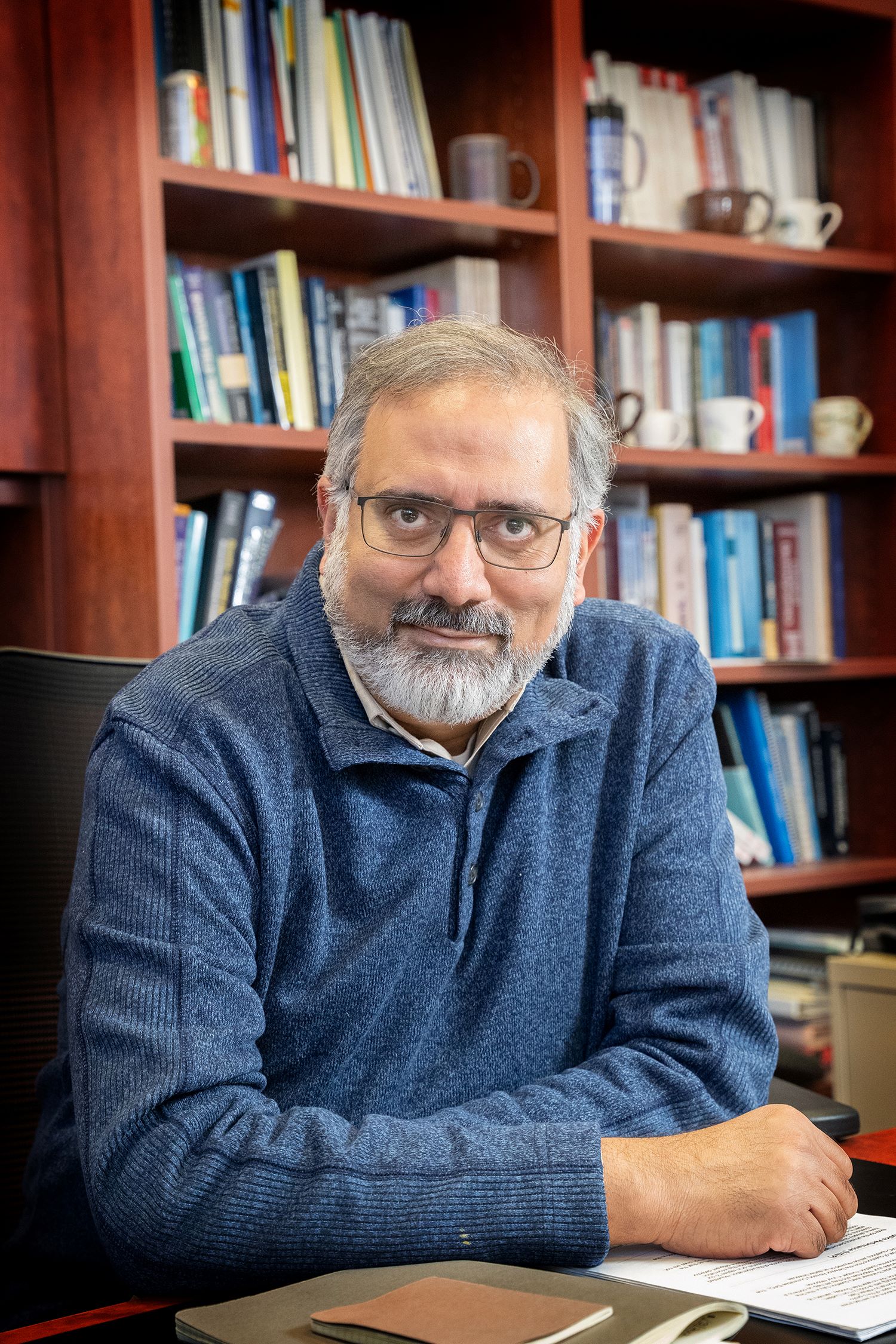Coming Full Circle: Leading the Way to New Science with Professor Abhay L. Deshpande
On August 1st, 2024 WPI-SKCM² started the month off right with a very exciting visit from Professor Abhay L. Deshpande from Stony Brook University’s Department of Physics and Astronomy!
He traveled all the way from New York City, USA to visit our PI Kenta Shigaki for WPI collaborations and to give a seminar about the 3.8 kilometer Electron-Ion Collider also known as the EIC being built (and near completion) on Stony Brook University’s campus. This collider can address problems such as probing the gravitational internal structure of protons and nuclei with a direct connection to chirality and providing experimental insight into the role of topology in hadronic systems.
Prof. Deshpande is an Affiliate Member of WPI-SKCM² because of his exciting ideas and work related to both chirality and topology. He has made significant contributions over decades to understanding the structure and emergent properties of composite particles like protons and neutrons from the collective chiral interactions of quarks and gluons. You can see his engaging and easy to understand explanations in this interview!
Additionally, through the interview, we were able to learn that his connections to the project and Japan have roots going back to the beginning of his academic journey! We also heard his thoughts on leadership, and what motivates him to continue pursuing discovery.
Interviewer: So I will start with my first question which is… How are you today?
Prof. Deshpande: I am doing fine! [It was a] wonderful talk, lots of questions and discussions now. Just chatting with the students here and the faculty, so I’m having a very good day today.
I: That’s good! I’m glad to hear it. And I assume your talk went well?
Prof. Deshpande: Well let’s ask them. (Gestures to students in the room) They’re the ones who could tell me. How was the talk?
Students: It was good.
I: So you’re involved with Riken [one of Japan’s national laboratories], correct?
Prof. Deshpande: Used to be, yes.
So, I was a postdoc at CERN. I wanted to do this polarized proton beam physics, which was happening at Brookhaven National Lab at that time. And RIKEN had invested money in a new center at Brookhaven National Lab called RIKEN BNL Research Center or “RBRC” (…. led by TD Lee, the Nobel Prize winner and Nick Samuels).
There were people in polarized spin physics who had seen me as a postdoc during talks and doing work at CERN and also at DESY Germany [and] they invited me to apply for this fellowship. February of 2000 [I joined this…] place in which the polarized proton beams were planning to be collided. It [is]the only place in the world which still has polarized beams. No other place in the world has that. So if you wanted to study the spin of the proton, there was one place in the world that you could go to. That’s how I came to be at Riken BNL Research Center.
I: So it was very natural.
Prof. Deshpande: It was very natural. If you wanted that physics you had to come there.
I: So is this your first time in the Hiroshima area or have you…
Prof. Deshpande: Oh no, I’ve been to Hiroshima on my first trip in 1998. I came as a postdoc on a JSPS fellowship. And I came and gave a talk here at the department of the University. Amazingly enough it was on the Electron-Ion Collider. It was one of the earliest talks that I gave. That was 27 years ago. That’s when I started thinking about this collider. It was very brand new. But yeah, it’s been a long time. Now it’s actually happening, what I started as a postdoc.
I: That’s great to hear. So, from there I was going to ask you some probably silly things about the collider. From your talk I understood that this collider (BNL’s collider) is slightly smaller than other colliders?
Prof. Deshpande: Smaller than one other that is operational, but the size doesn’t matter. Size matters in energy. If you want it to go to higher energy you need a longer, bigger collider. But what we’re looking for does not require higher energy. In fact if we go to higher energy, we miss the point. So the higher the energy, the smaller the distances we can see. And that, the CERN collider can do better. We don’t need to go and compete. However, we want to go to just enough energy to look at some variable distances in the size of the proton. And if you want to do it, then this is the right size. So that’s why we are setting on this size.
I: You’re making the perfect size for [your purposes].
Prof. Deshpande: We’re making the perfect size. If you made it smaller than this, you wouldn’t see the interesting part of inside the proton. If you make it bigger than this, we will certainly start seeing very small distances, and then it will miss the interactions that happen around a quark. That’s what we’re interested in. We are interested in the collective behavior; how the group of quarks and a group of gluons will behave [together].
It’s like a young child who is playing alone, and the kind of play the child does by himself or herself is different for the same child in a group of 15 children. How they behave is what we want to understand. Not the individual. We understand how they will behave [individually]. The chaos a group of children make is what I am more interested in. How the chaos will begin, and how does that interaction begin. That’s what we want to study. The collective behavior. It’s an ordered chaos in that it’s not a complete uncontrolled chaos because it always happens inside the proton. It never leaves the proton. So you can leave the kids in the room and they will never leave the room. They’re all safe. They’re all doing well, but they have a different dynamic compared to a single child running around in the same room. That’s what is interesting.
I: Do you have any expectations about what you will see from these interactions?
Prof. Deshpande: It’s very difficult to [predict] that. You see, the interactions are very complicated, because of the nature of the gluons that are being exchanged. It’s unpredictable. There is some predictive power, but we don’t know if that is the right direction or not. Some people have done calculations, so we can think about certain things that might happen. But whether they will actually happen we have to test experimentally. And that is unique about QCD, or Quantum Chromodynamics. Anything that you see somewhere and extrapolate in some dimension it’s not always possible to predict 100% that it will happen. It always has surprised us historically. So, yes, we have predictive power, but I bet that we’ll see very different things because of that collective behavior and collective chaos that exists in that interaction.
I: So it’s very exciting to find out what they’re going to do.
Prof. Deshpande: Exactly. It’s very hard to predict. If you predict something and you find exactly that, you learned that your mathematical tools that you developed are correct, so that’s good. But it is more fun when you predict something but you find something completely different. Then you’re baffled, then you find something new. Then you learn something absolutely different. So you can’t lose. You either improve your confidence in the theory that we now have, or you say “okay we need a new theory to explain something outside”. Both ways we win.
I: That’s such a nice way of looking at it. I’m sure there are some people who feel that if it’s not within their prediction they feel…
Prof. Deshpande: Dejected? No, no, no in fact all of the surprises are where you learn.
I: So, you have been in many leadership roles. For example, now you’re the science director of the collider. How do you manage that position of power? What are good ways to direct people?
Prof. Deshpande: The good thing about this position is to identify good science and that you always do by talking to good scientists. So the nice part about the job is I constantly talk to better scientists than I am. So, it is not directing people but collecting ideas and exploring them and making them experimentally viable. In the meantime making those bonds that are necessary in a large collaboration. It’s a lot more of a scientific outreach but also scientific development of new ideas. If you can bring people together and channel their effort in a certain direction, that’s much better and people are a lot more motivated to pursue something that is their own goal, their own science. I don’t want them to follow just because I like that science. If I like it and think it’s important then more people should be involved, that’s how I look at it. And as long as you convince more people, then that’s all the job you need to do.
So building collaborations is what it is. Starting from when I first came in 98 and I gave this talk, I think there were 15 people in the world who wanted to do this. Now there are 1,500. There’s a reason for it and that’s good! There’s a lot of money from different countries being invested in this. The science had better be good. So if the science is good, more people will join.
—–
It was such a great pleasure to have Professor Deshpande return to us after 27 years to once again share with Hiroshima University, and more specifically WPI-SKCM², the science of the Electron-Ion Collider. The machine that was conceptualized during his time as a postdoc with JSPS is finally becoming a reality. He found the science, and followed it to this goal. We are sure we can say that it was largely thanks to Professor Desphande’s guidance, and gentle leadership focusing on finding good science and scientists to lead the project to its goal.
So, we hope the members of WPI-SKCM² will also have the courage and patience to follow the science they are passionate about. The road may be long, but the journey will always include exciting discoveries and learning opportunities. And, even if at first you have few companions on your journey, if the science is good, you will surely pick up more along the way.
As a new institute, we can learn a lot from Professor Deshpande’s approach as we build our own networks of scientists. Luckily, he is already part of our network and a part of the effort to spread the science of “knotted chiral meta matter” and gather more passionate scientists, working to use what we learn about knotted chiral meta matter to create a sustainable future.



